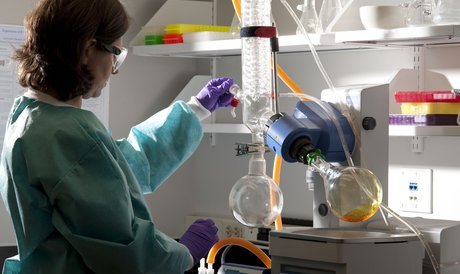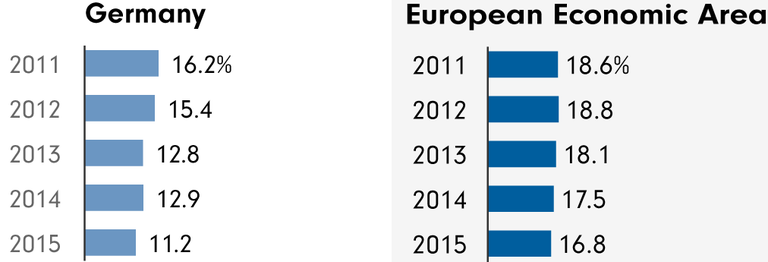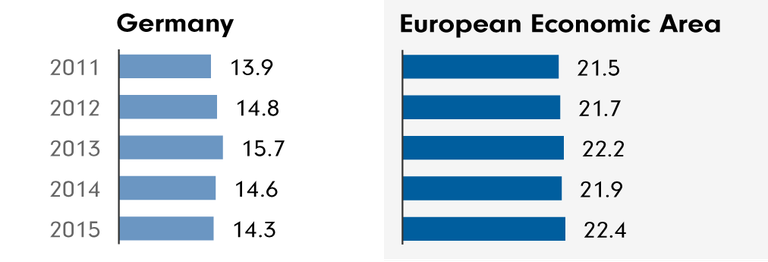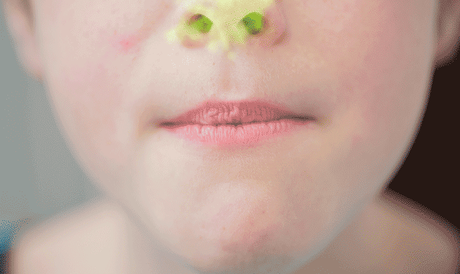
Germany
The emergence of bacteria that cause infections in humans which are resistant to treatment with antibiotics has become a global public health concern.
Infections by multi-resistant germs are estimated to kill around 25,000 people in the EU every year, with some experts estimating that this number will increase dramatically over the coming decades.
But the situation between each member states varies hugely. Some countries have strict rules around antibiotic consumption and some don’t. The EU bodies responsible for addressing the problem recognise that there is no one-size-fits-all solution. This is why it is important to understand the situation in individual countries.
MRSA prevalence
Percent of hospital Staphylococcus aureus isolates that are resistant to methicillin

Source: ECDC
In terms of antibiotic consumption, Germany is in sixth place in the EU with 14.4 daily doses of antibiotics per 1,000 people. This is a relatively good value. Germans are close to the European average when it comes to ignorance regarding antibiotic use, at 57 per cent. This means that roughly every second person in Germany would consider an antibiotic to be useful in treating a cough or a cold.
Livestock consumption of antibiotics in Germany
Consumption of antibiotics in animal production in Germany is approximately 200 milligrams per kilogram of meat, which is again close to the European average. When it comes to the total livestock consumption of antibiotics, Germany has the second highest in Europe with 1,300 tonnes, behind Italy. A few years ago, Germany was the leader in livestock consumption of antibiotics, but since then farmers have significantly reduced their use of antibiotics.
The massive use of antibiotics in animal production is problematic for humans. Bacteria which affect both animals and humans can develop resistance to antibiotics in animals, making antibiotic treatment ineffective against the bug when it causes an infection in humans. Bacteria which only affect animals can also pass their resistance on to pathogenic bacteria which cause diseases in humans.
Different non-governmental organisations are involved in this issue. The Buko Pharma-Kampagne, for example, calls on the Federal Government to establish a fund to finance research into new antibiotics.An online petition calls for German health insurance companies to boycott dirty antibiotic manufacturers. The manufacturers reportedly don’t eliminate resistant germs from their wastewater, thus assisting the formation of resistant germs.
Hospital infections
The European Centre for Disease Prevention and Control (ECDC) also records healthcare associated infection (HAI) prevalence in European hospitals. This data shows what percentage of hospital patients have a hospital acquired infection – a large proportion of these infections are preventable, and are caused by poor hygiene.
Antibiotic consumption in humans
Daily doses per 1000 inhabitants per day

Source: ECDC
The European average for HAI prevalence was 6.12%. In Germany, this number was below average at 5%.
An ECDC report which looked at infections and antibiotic use in European hospitals in 2011-12 reported on hospitals indicators like the use of alcohol hand rub and the number of single beds.
These indicators are important because they are measures that help to keep the rate of hospital acquired infections low, which helps to counter resistance – because the fewer infections patients acquire, the fewer antibiotics are used, and the less resistance can develop.
Single rooms are important because they can be used to isolate patients who have infections, preventing the infection from spreading. The amount of alcohol hand rub used indicates how well hospital staff are disinfecting their hands and following hygiene procedures – the more hand rub used, the less chance infections have of spreading.
The report found that Germany was below the European average on four of the indicators recorded – the amount of alcohol hand rub used in hospitals, the proportion of hospital beds that were in single rooms, and the numbers of both doctors and nurses who were dedicated to infection prevention and control in each hospital.
Germany had a below average use of alcohol hand rub – just 19.52 litres per 1,000 patient days, compared to the European average of 25.64 litres.
German hospitals, on average, had just 6.53 per cent of their beds in single rooms, compared to the European average of 15.29 per cent.
And when it comes to the number of doctors and nurses dedicated to infections, Germany fared no better. There were the equivalent of just 0.53 infection nurses per 250 hospital beds, and 0.04 infection doctors per 250 beds. This compared to a European average of 0.97 and 0.38 respectively. Germany had the sixth lowest number of infection nurses, and the sixth lowest of infections doctors, of all the European countries that the ECDC gathered data from.
-

-

Seven things YOU can do to combat antibiotic resistance
Because we can all help in the fight against resistant bugs.
-

A new TV documentary reveals that superbugs are multiplying in the polluted wastewater flowing from pharmaceutical plants in India
-

Less than half of antibiotics used in hospitals worldwide are prescribed appropriately, confirms a comprehensive new study
-

Projected death toll from drug-resistant superbugs 'based on incomplete data and flawed assumptions'
-

More antibiotics, more resistant germs
Antibiotic consumpion varies largely between countries
-

Lost life
More than two million Europeans are infected in hospital every year, according to the most comprehensive study to date
-

Treasures straight out of our nose
Researchers from Tübingen discover an antibiotic against MRSA in the human nose
-

Fear of Bacteria
Why resistances against antibiotics has rather become an overestimated than an underestimated problem.
